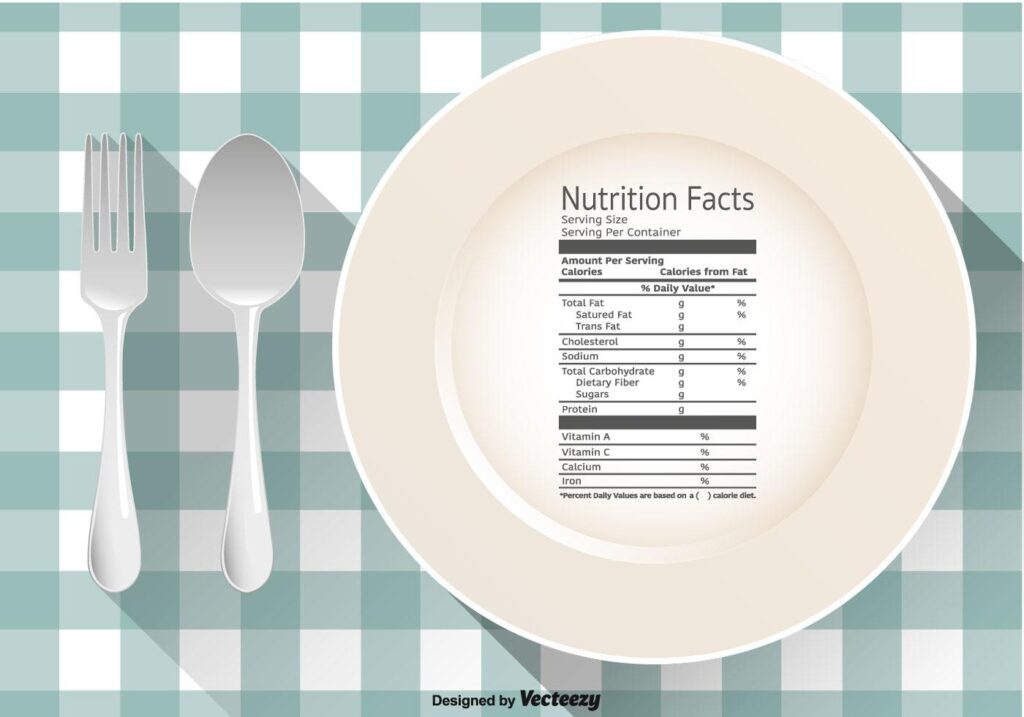Introduction
In today’s fast-paced world, where convenience often trumps healthy eating, understanding nutrition labels is essential for making informed food choices. Nutrition labels serve as a beacon in a sea of packaged food options, guiding consumers towards choices that align with their dietary needs and health goals.
These labels provide a roadmap to navigate the intricate world of food, empowering individuals to make conscious decisions about the substances they nourish their bodies with.Nutrition labels, like miniature nutritional encyclopedias, offer a wealth of information about the nutrient content of packaged foods.
They unravel the mysteries of food components, revealing the presence of essential vitamins, minerals, fats, carbohydrates, and protein. This treasure trove of data enables consumers to assess the nutritional value of various food products, make informed comparisons, and select those that contribute positively to their overall health.
Purpose of Nutrition Labels

Nutrition labels serve a crucial purpose in empowering consumers to make informed decisions about their food choices. They provide standardized information about the nutrient content of packaged foods, allowing consumers to compare different products and make choices that align with their dietary needs and preferences.
Nutrition labels are mandatory on most packaged foods and beverages in many countries around the world. These labels, in simple and standardized format, present detailed and crucial information about the foods we consume. They reveal the amount of energy, nutrients, and specific ingredients.
So, why are nutrition labels essential for every informed food consumer? Consider these reasons:
Making informed choices with nutrition labels :
Nutrition labels play a pivotal role in empowering consumers to make healthy and informed food choices. We can use the data we gain from nutrition labels to compare different products and avoid unnecessary consumption of harmful substances like unhealthy fats or excessive sugar.
Supporting dietary needs:
Nutrition labels serve as a helpful guide for those with specific dietary needs. When trying to reduce a certain food group, such as dairy or gluten, nutrition labels can be a source of truth to assist with making smart choices within those restrictions.
Understanding ingredient profiles:
Nutrition labels help us understand the exact ingredients of our food. This allows us to be aware of potential allergens or dietary triggers that may affect our health, such as artificial ingredients or preservatives.
Managing health goals:
When trying to achieve specific health goals, such as losing weight or improving heart health, nutrition labels provide useful information to track calories, nutrient intake, and overall nutritional balance.
In conclusion, nutrition labels are valuable tools that empower consumers to make informed food choices, manage their health and wellness, and support their journey towards a healthier lifestyle. Understanding the information provided on nutrition labels allows us to take control of our food choices and achieve our specific dietary goals.
Whether we aim to control our calorie intake, maintain a balanced diet, or avoid unwanted ingredients, nutrition labels are powerful assets that equip us with the knowledge to make food decisions that best support our well-being.
Key Components of Nutrition Facts Labels
Nutrition labels typically include the following key components:
Serving Size: The Key to Comparing Nutrient Amounts
When comparing nutrient amounts across different products, it is essential to pay attention to the serving size. The serving size represents the amount of food typically consumed in one serving. This information is displayed on the Nutrition Facts label and is usually expressed in common household measures, such as cups, tablespoons, or pieces.
Why is serving size important?
- Comparing nutrient amounts based on different serving sizes can lead to inaccurate conclusions about the relative nutritional value of two products.
- For example, a cereal with a larger serving size might appear to have more calories than a cereal with a smaller serving size, even if the two products have similar calorie contents per serving.
How to compare nutrient amounts using serving sizes?
- Locate the serving size information on the Nutrition Facts label of each product.
- Divide the nutrient amounts by the serving size to calculate the nutrient content per serving.
- Compare the nutrient content per serving of the two products.
- Choose the product with the lowest amount of unhealthy nutrients, such as saturated fat, sodium, and added sugars, and the higher amount of healthy nutrients, such as fiber, whole grains, and vitamins.
Tips for measuring serving sizes:
- Use common household measuring cups and spoons.
- If you don’t have measuring cups or spoons, you can use a kitchen scale.
- If you are unsure of the serving size, you can check the manufacturer’s website or the USDA National Nutrient Database.
By paying attention to serving sizes, you can make informed decisions about your food choices and support your overall health and wellness.
Calories: Unleashing the Energy Content of Food
Decoding the intricate world of nutrition labels involves understanding not just nutrient amounts but also energy content. Calories, represented on every nutrition label, serve as a measure of the energy a food provides. This energy measurement plays a crucial role in managing calorie intake and maintaining a healthy weight.
The Role of Calories in Nutrition
Calories represent the amount of energy stored in food. When we consume food, our bodies break down the nutrients, releasing energy that powers our cells and allows us to function. Calories not immediately used as energy are stored in the body as fat.
Understanding the calorie content of foods is essential for maintaining a healthy energy balance. Consuming more calories than we expend leads to weight gain, while consuming fewer calories results in weight loss. Therefore, balancing calorie intake with energy expenditure is crucial for maintaining a healthy weight and overall well-being.
Navigating Calorie Counts on Nutrition Labels
Calorie information is conveniently displayed on the Nutrition Facts label, typically alongside serving size details. This information provides valuable insights into the energy content of a particular food. However, interpreting calorie counts effectively requires careful consideration.
Tips for Utilizing Calorie Information
- Understand Serving Sizes: Before evaluating calorie counts, pay attention to serving sizes. Comparing calorie amounts without considering serving sizes can lead to misinterpretations.
- Consider Daily Calorie Needs: Individual calorie needs vary based on factors like age, gender, activity level, and overall health. Determine your daily calorie needs to assess how a particular food fits into your overall calorie intake.
- Factor in Your Lifestyle: Adjust your calorie intake based on your lifestyle. If you engage in regular physical activity, you may need to consume more calories to fuel your body.
- Balance Calories with Nutrient Density: While calorie counts are important, don’t overlook nutrient density. Prioritize foods that provide essential nutrients alongside your calorie intake.
By understanding the significance of calorie content and effectively utilizing calorie information on nutrition labels, individuals can make informed food choices that align with their health goals. Calories, when considered alongside other nutritional factors, play a crucial role in maintaining a healthy and balanced diet.
Delving into the World of Nutrients: Unveiling the Importance of Nutrients on Nutrition Labels

Navigation through the world of food labels extends beyond merely understanding calories; it demands an exploration of the essential nutrients that support our overall health and well-being.
Nestled within the Nutrition Facts label is a comprehensive array of nutrients, including vitamins, minerals, fats, carbohydrates, and protein, each playing a pivotal role in maintaining our body’s intricate functions.
Vitamins: The Life-Essential Micronutrients
Vitamins, acting as the body’s fundamental building blocks, are essential for a myriad of physiological processes. These indispensable micronutrients contribute to everything from maintaining healthy vision and immune function to supporting strong bones and a healthy nervous system.
Nutrition labels provide valuable insights into the vitamin content of food, enabling us to identify sources of essential vitamins such as vitamin A, vitamin C, vitamin D, and B vitamins.
Minerals: The Inorganic Partners in Health
Minerals, the inorganic counterparts to vitamins, are equally crucial for maintaining optimal health. These elements, ranging from calcium for strong bones and teeth to iron for oxygen transport, play a vital role in regulating bodily functions and ensuring cellular processes operate smoothly.
Nutrition labels inform us about the mineral content of food, helping us identify sources of essential minerals such as potassium, magnesium, zinc, and selenium.
Fats: The Diverse Duo – Saturated and Unsaturated
Fats, often vilified for their potential contribution to weight gain, serve diverse and essential roles in the body. They provide sustained energy, transport essential vitamins, and act as building blocks for cell membranes.
Nutrition labels categorize fats into two broad types: saturated and unsaturated. Saturated fats, often found in animal products, should be consumed in moderation, while unsaturated fats, particularly monounsaturated and polyunsaturated fats, found in plant-based sources, are beneficial for health.
Carbohydrates: The Body’s Primary Energy Source
Carbohydrates, often portrayed as the antagonists of weight loss, represent the body’s primary energy source. They provide fuel for the brain, muscles, and other tissues. Nutrition labels differentiate between two main types of carbohydrates: simple carbohydrates and complex carbohydrates.
Simple carbohydrates, such as those found in sugary drinks and processed foods, should be limited, while complex carbohydrates, such as those found in whole grains, fruits, and vegetables, are essential for maintaining a healthy diet.
Protein: The Building Blocks of Life
Protein, the scaffolding of our bodies, is composed of amino acids, the building blocks of tissues, enzymes, and hormones. Nutrition labels provide information about the protein content of food, enabling us to identify sources of complete proteins, containing all nine essential amino acids, and incomplete proteins, containing a limited number of essential amino acids.
Nutrition Labels – A Gateway to Informed Food Choices
Nutrients, the foundation of our health, play a multifaceted role in maintaining overall well-being. Nutrition labels, by providing insights into the vitamin, mineral, fat, carbohydrate, and protein content of food, empower us to make informed food choices that support our health goals. Armed with this knowledge, we can navigate the world of food with confidence, ensuring our bodies receive the essential nutrients they need to thrive.
Percent Daily Values (DV): Unveiling the Nutritional Significance of a Single Serving
In the realm of nutrition labels, Percent Daily Values (DVs) hold a prominent position, providing a quantifiable measure of the nutritional significance of a single serving of food. Established by the FDA, DVs serve as standardized reference points for assessing the nutrient content of food, empowering consumers to make informed food choices aligned with their dietary needs and health goals.
Delving into the Role of Percent Daily Values
Percent Daily Values, expressed as percentages, represent the proportion of the recommended daily intake (DV) of a nutrient that a single serving of food provides. These values offer a quick and convenient way to gauge the contribution of a particular food to an individual’s overall nutrient intake.
Navigating Percent Daily Values on Nutrition Labels
Locating Percent Daily Values on nutrition labels is straightforward. Typically displayed adjacent to nutrient amounts, DVs are represented as percentages alongside the respective nutrient amounts. For instance, if a single serving of cereal provides 10% of the recommended daily intake of iron, the nutrition label will display “10% DV” next to the iron content.
Utilizing Percent Daily Values for Informed Food Choices
Percent Daily Values can be effectively utilized to make informed food choices. Here’s how:
- Identifying Nutrient Priorities: Determine the nutrients that are most relevant to your dietary needs and health goals. Focus on consuming foods with higher DVs for those nutrients.
- Assessing Overall Nutrient Intake: Consider the cumulative DVs of a particular nutrient across multiple food choices. Aim to reach the recommended daily intake (100% DV) for essential nutrients through a balanced diet.
- Balancing Nutrition and Preference: Strike a balance between consuming nutrient-dense foods with high DVs and enjoying foods you prefer. Moderation is key.
Empowering Choices with Percent Daily Values
Percent Daily Values serve as valuable tools for empowering consumers to make informed food choices. By understanding the significance of DVs and effectively utilizing this information, individuals can tailor their food intake to meet their specific nutritional needs and support their overall health and well-being.
Decoding Nutrient Information: The Pivotal Role of Serving Sizes
In the intricate world of nutrition labels, serving sizes occupy a central position, acting as the foundation for interpreting nutrient information accurately.
Serving sizes, standardized quantities that represent the typical amount of food consumed in one serving, play a crucial role in enabling informed food choices and assessing the nutritional value of different products.
The Significance of Serving Sizes
Serving sizes hold paramount importance in making meaningful comparisons between nutrient amounts across different food products. Failure to consider serving sizes can lead to flawed conclusions about the relative nutritional value of two products.
Consider the example of two cereals, Cereal A and Cereal B. Cereal A has a serving size of 1 cup, while Cereal B has a serving size of ½ cup. At first glance, Cereal A might appear to have double the calories of Cereal B. However, when calorie amounts are adjusted to reflect the same serving size (1 cup), we discover that both cereals have nearly identical calorie contents.
Navigating Serving Sizes on Nutrition Labels
Serving sizes are prominently displayed on nutrition labels, typically listed immediately below the product name. They are usually expressed in common household measures such as cups, tablespoons, pieces, or grams.
Tips for Utilizing Serving Sizes Effectively
When evaluating nutrient information, carefully consider the following tips:
- Locate Serving Sizes: Prior to comparing nutrient amounts, identify the serving sizes for each product.
- Adjust Nutrient Amounts: When comparing nutrient amounts across different serving sizes, adjust the nutrient values to reflect the same serving size for accurate comparisons.
- Consider Multiple Servings: If you typically consume more than one serving of a product, calculate the nutrient content based on the number of servings you typically consume.
Ensuring Accurate Nutrient Comparisons
Serving sizes stand as essential tools for ensuring accurate nutrient comparisons and making informed food choices. By carefully paying attention to serving sizes and adjusting nutrient amounts accordingly, individuals can effectively assess the nutritional value of different products and tailor their food intake to support their health goals.
Conclusion
Nutrient information on food labels can be overwhelming at first glance. However, with a bit of understanding, it can be a valuable tool for making informed food choices. Here are some tips for interpreting nutrient information:
Focus on nutrients of concern: Identify nutrients that are important for your health goals or dietary needs. For example, if you are trying to reduce your fat intake, pay close attention to the fat content of the foods you choose.
Compare nutrient amounts across products: When comparing similar products, look for the ones with lower amounts of unhealthy nutrients, such as saturated fat, sodium, and added sugars, and higher amounts of healthy nutrients, such as fiber, whole grains, and vitamins.
Consider your overall diet. Don’t focus solely on the nutrient content of individual foods. Consider the overall balance of nutrients in your diet.
Common Questions about Nutrition Labels
1. What is the difference between Percent Daily Values (DV) and Recommended Daily Intake (RDI)?
Percent Daily Values (DV) represent the percentage of the recommended daily intake (RDI) of a nutrient that a single serving of the food provides. RDI is the average daily intake level of a nutrient that is considered sufficient to meet the needs of most healthy individuals.
2. What does “serving size” mean on a food label?
Serving size is the amount of food typically consumed in one serving. It is important to pay attention to the serving size when comparing nutrient amounts across different products.
3. What are “added sugars”?
Added sugars are sugars that are added to food during processing or preparation. They contribute to overall calorie intake and can increase the risk of chronic diseases such as obesity and heart disease.
4. What is the difference between total fat and saturated fat?
Total fat refers to the total amount of fat in a food, including both saturated and unsaturated fat. Saturated fat is a type of fat that can raise blood cholesterol levels and increase the risk of heart disease.
5. What is the best way to use nutrition labels to make healthy food choices?
Focus on nutrient-dense foods with high amounts of vitamins, minerals, fiber, and whole grains. Limit foods with high amounts of saturated fat, sodium, and added sugars. Pay attention to serving sizes and compare nutrient amounts across similar products.







